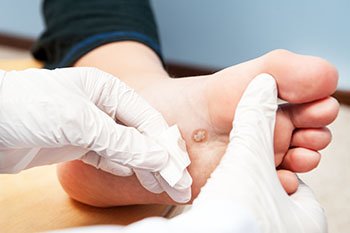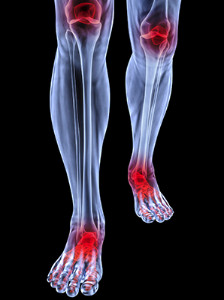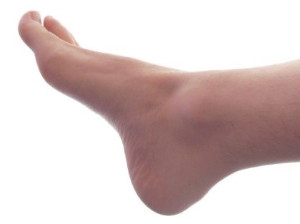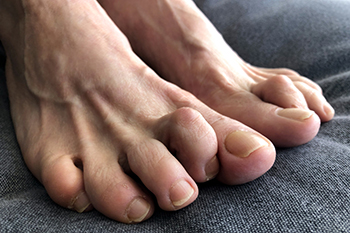Items filtered by date: August 2022
Foot Warts in Children

Plantar, or foot warts, are common in children. These warts are lumps that have hardened skin, are typically gray or brown in color, and have irregular surfaces. They are usually located on the heel or sole of the foot – areas that bear most body weight. Plantar warts are not always serious, but they can affect life quality. Foot warts in kids are caused by the human papillomavirus (HPV) and are aesthetically displeasing. Not all children with HPV will get plantar warts. They can occur from walking barefoot on floors containing the virus. Warm, wet areas, like public swimming pools, bathrooms, and changing rooms, are ideal breeding grounds for the virus. Oftentimes, there is a small wound on the foot, which provides an entrance for the foot wart. Plantar warts develop very slowly and may take up to a year to become visible. Symptoms vary depending on the location of the wart. They may hurt when walking and can get infected. If your child has a plantar wart, visit a podiatrist who can offer options for treatment.
Plantar warts can be very uncomfortable. If you need your feet checked, contact one of our podiatrists from Houston Foot and Ankle Care. Our doctors will assist you with all of your foot and ankle needs.
About Plantar Warts
Plantar warts are the result of HPV, or human papillomavirus, getting into open wounds on the feet. They are mostly found on the heels or balls of the feet.
While plantar warts are generally harmless, those experiencing excessive pain or those suffering from diabetes or a compromised immune system require immediate medical care. Plantar warts are easily diagnosed, usually through scraping off a bit of rough skin or by getting a biopsy.
Symptoms
- Lesions on the bottom of your feet, usually rough and grainy
- Hard or thick callused spots
- Wart seeds, which are small clotted blood vessels that look like little black spots
- Pain, discomfort, or tenderness of your feet when walking or standing
Treatment
- Freezing
- Electric tool removal
- Laser Treatment
- Topical Creams (prescription only)
- Over-the-counter medications
To help prevent developing plantar warts, avoid walking barefoot over abrasive surfaces that can cause cuts or wounds for HPV to get into. Avoiding direct contact with other warts, as well as not picking or rubbing existing warts, can help prevent the further spread of plantar warts. However, if you think you have developed plantar warts, speak to your podiatrist. He or she can diagnose the warts on your feet and recommend the appropriate treatment options.
If you have any questions please feel free to contact our offices located in Inner Loop, Southwest, Greater Heights, and Pearland, TX . We offer the newest diagnostic and treatment technologies for all your foot and ankle needs.
Heel Pain Can Be Treated!
How to Care For Arthritic Feet

Arthritis can cause a lot of pain and discomfort in your feet. Walking and standing might be uncomfortable due to problems with your heels, ball of foot, ankle, or toes. There are various things you can do to attempt to lessen your pain. Feet need circulation, especially if you have arthritis. This requires that you keep blood moving through them – by walking, taking warm foot baths, getting foot massages, and raising your feet when reclining. Examine your feet for bumps, sores, or discolored areas and monitor any changes in how your feet feel. Avoid bad habits, such as wearing ill-fitting shoes, sitting too long without stretching, smoking, and exposing your feet to cold temperatures. Wear warm socks and comfortable padded shoes in colder months. Do not ignore problems with your feet as you could be putting them at risk of more injury. If you have arthritis and notice problems with your feet, make an appointment with a podiatrist who can diagnose and provide treatment options for you.
Arthritis can be a difficult condition to live with. If you are seeking treatment, contact one of our podiatrists from Houston Foot and Ankle Care. Our doctors can provide the care you need to keep you pain-free and on your feet.
Arthritic Foot Care
Arthritis is a joint disorder that involves the inflammation of different joints in your body, such as those in your feet. Arthritis is often caused by a degenerative joint disease and causes mild to severe pain in all affected areas. In addition to this, swelling and stiffness in the affected joints can also be a common symptom of arthritis.
In many cases, wearing ill-fitting shoes can worsen the effects and pain of arthritis. Wearing shoes that have a lower heel and extra room can help your feet feel more comfortable. In cases of rheumatoid arthritis, the arch in your foot may become problematic. Buying shoes with proper arch support that contour to your feet can help immensely.
Alleviating Arthritic Pain
- Exercises that stretch the foot can prevent further pain and injury and increase mobility
- Most of the pain can be alleviated with anti-inflammatory drugs, heat, and topical medications
- Massages can help temporarily alleviate pain.
It is best to see your doctor for the treatment that is right for your needs and symptoms. Conditions vary, and a podiatrist can help you determine the right method of care for your feet.
If you have any questions, please feel free to contact our offices located in Inner Loop, Southwest, Greater Heights, and Pearland, TX . We offer the newest diagnostic tools and technology to treat your foot and ankle needs.
What Is Hallux Rigidus?

Hallux rigidus is a condition that typically affects the joint between the first long bone of the foot and the big toe. It is called the metatarsophalangeal joint, or MTP for short. Pressure on the bones, ligaments, and tendons of the MTP joint caused by wearing ill-fitting shoes or standing for long periods of time can result in inflammation. The big toe becomes stiff and painful, making it difficult to walk with a normal gait. A faulty distribution of body weight further aggravates the joint and can lead to the destruction of the cartilage. The big toe will hurt when it is moved up and down and sometimes a bone spur will form on the end of the first metatarsal bone. Alterations to footwear, such as avoiding high heels and wearing shoes with a roomier toe box, can bring some relief, but will not stop the progression of the hallux rigidus. It is wise to treat it early for better results. If the stiffness in the big toe does not go away after a few days, please seek the guidance of a podiatrist, who may prescribe both medication and custom orthotics. In more advanced cases, surgery may be an option.
Toe pain can disrupt your daily activities. If you have any concerns, contact one of our podiatrists of Houston Foot and Ankle Care. Our doctors can provide the care you need to keep you pain-free and on your feet.
What Causes Toe Pain?
Most severe toe pain is caused due to a sports injury, trauma from dropping something heavy on the toe, or bumping into something rigid. Other problems can develop over time for various reasons.
Toe pain can be caused by one or more ailments. The most common include:
- Trauma
- Sports injury
- Wearing shoes that are too tight
- Arthritis
- Gout
- Corns and calluses
- Hammertoe
- Bunions
- Blisters
- Ingrown toenails
- Sprains
- Fractures (broken bones)
- Dislocations
When to See a Podiatrist
- Severe pain
- Persistent pain that lasts more than a week
- Signs of infection
- Continued swelling
- Pain that prevents walking
Diagnosis
In many cases the cause of toe pain is obvious, but in others, a podiatrist may want to use more advanced methods to determine the problem. These can range from simple visual inspections and sensation tests to X-rays and MRI scans. Prior medical history, family medical history, and any recent physical traumatic events will all be taken into consideration for a proper diagnosis.
Treatment
Treatments for toe pain and injuries vary and may include shoe inserts, padding, taping, medicines, injections, and in some cases, surgery. If you believe that you have broken a toe, please see a podiatrist as soon as possible.
If you have any questions please feel free to contact our offices located in Inner Loop, Southwest, Greater Heights, and Pearland, TX . We offer the newest diagnostic tools and technology to treat your foot and ankle needs.
A Stress Fracture Can Be Called a Fatigue Fracture

A stress fracture in the foot is common among people who enjoy running and participating in sporting activities. It is considered to be a hairline fracture, and gradually happens from repetitive stress that is put on the bones in the feet. People may refer to it as a fatigue fracture, and it is a weakening of the bone. There may be additional risk factors at play in why some people develop stress fractures and others do not. These can include not consuming enough calories, having an earlier stress fracture, or possibly from having low body weight. Many people can endure a stress fracture from training too rapidly and frequently, as this does not allow adequate time for the bones to get used to the added stress. Additionally, if running is done on hard surfaces, it may contribute significantly to getting a stress fracture. Relief generally begins with stopping the activity that caused the fracture, and resting the affected foot which may help to relieve swelling. If you have endured a stress fracture, it is advised that you speak with a podiatrist as quickly as possible so the correct treatment can begin.
Stress fractures occur when there is a tiny crack within a bone. To learn more, contact one of our podiatrists from Houston Foot and Ankle Care. Our doctors can provide the care you need to keep you pain free and on your feet.
How Are They Caused?
Stress fractures are the result of repetitive force being placed on the bone. Since the lower leg and feet often carry most of the body’s weight, stress fractures are likely to occur in these areas. If you rush into a new exercise, you are more likely to develop a stress fracture since you are starting too much, too soon. Pain resulting from stress fractures may go unnoticed at first, however it may start to worsen over time.
Risk Factors
- Gender – They are more commonly found in women compared to men.
- Foot Problems – People with unusual arches in their feet are more likely to develop stress fractures.
- Certain Sports – Dancers, gymnasts, tennis players, runners, and basketball players are more likely to develop stress fractures.
- Lack of Nutrients – A lack of vitamin D and calcium may weaken the bones and make you more prone to stress fractures
- Weak Bones – Osteoporosis can weaken the bones therefore resulting in stress fractures
Stress fractures do not always heal properly, so it is important that you seek help from a podiatrist if you suspect you may have one. Ignoring your stress fracture may cause it to worsen, and you may develop chronic pain as well as additional fractures.
If you have any questions, please feel free to contact our offices located in Inner Loop, Southwest, Greater Heights, and Pearland, TX . We offer the newest diagnostic and treatment technologies for all your foot care needs.
Two Types of Hammertoe

When the toe joints become out of balance a condition known as hammertoe may develop. This is considered to be a deformity and can happen from wearing shoes that do not have adequate room for the toes to move freely. The joints in the toes become affected and can bend downward, resembling a hammer. Additionally, genetic reasons may cause this condition to occur, where there is an imbalance in the tendons. An injury to the toes may cause a hammertoe to develop and many times corns and calluses form on top of the bent toes. Research has indicated that is important to wear shoes that fit correctly. A shoe that fits well has enough space between the longest toe and the top of the shoe, ensuring the toe will not touch that part of the shoe. Flexible hammertoe generally happens in the beginning stages of this ailment. This is noticeable because the toes can still be straightened despite being in a fixed position. When the toes are unable to straighten this is classified as rigid hammertoe, and surgery may be necessary to correct it. If you notice signs of hammertoe, please consult with a podiatrist who can guide you toward the correct treatment techniques.
Hammertoe
Hammertoes can be a painful condition to live with. For more information, contact one of our podiatrists from Houston Foot and Ankle Care. Our doctors will answer any of your foot- and ankle-related questions.
Hammertoe is a foot deformity that affects the joints of the second, third, fourth, or fifth toes of your feet. It is a painful foot condition in which these toes curl and arch up, which can often lead to pain when wearing footwear.
Symptoms
- Pain in the affected toes
- Development of corns or calluses due to friction
- Inflammation
- Redness
- Contracture of the toes
Causes
Genetics – People who are genetically predisposed to hammertoe are often more susceptible
Arthritis – Because arthritis affects the joints in your toes, further deformities stemming from arthritis can occur
Trauma – Direct trauma to the toes could potentially lead to hammertoe
Ill-fitting shoes – Undue pressure on the front of the toes from ill-fitting shoes can potentially lead to the development of hammertoe
Treatment
Orthotics – Custom made inserts can be used to help relieve pressure placed on the toes and therefore relieve some of the pain associated with it
Medications – Oral medications such as anti-inflammatories or NSAIDs could be used to treat the pain and inflammation hammertoes causes. Injections of corticosteroids are also sometimes used
Surgery – In more severe cases where the hammertoes have become more rigid, foot surgery is a potential option
If you have any questions please contact our offices located in Inner Loop, Southwest, Greater Heights, and Pearland, TX . We offer the newest diagnostic and treatment technologies for all your foot and ankle needs.


